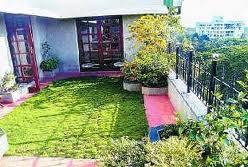 Terrace gardening is an element where a raised flat paved or graveled section overlooks a prospect. A raised terrace keeps a house dry and provides a transition between the hard materials of the architecture and softer ones of the garden.
Terrace gardening is an element where a raised flat paved or graveled section overlooks a prospect. A raised terrace keeps a house dry and provides a transition between the hard materials of the architecture and softer ones of the garden.
Since a level site is generally regarded as a requisite for comfort and repose, the terrace as a raised viewing platform made an early appearance in the Persian gardening tradition, where the enclosed orchard, or paradise, was to be viewed from a ceremonial tent.
Such a terrace had its origins in the far older agricultural practice of terracing a sloping The Hanging Gardens of Babylon must have been built on an artificial mountain with stepped terraces, like those on a ziggurat. Lucullus brought back to Rome first-hand experience of Persian gardening in the hilly sites of Asia Minor; the villa gardens of Maecenas, which included libraries open to scholars, incurred the disdain of Seneca. At Praeneste during the early Imperial period, the sanctuary of Fortuna was enlarged and elaborated, the natural slope being shaped into a series of terraces linked by stairs.
The imperial villas at Capri were built to take advantage of varied terraces. At the seaside Villa of the Papyri in Herculaneum, the villa gardens of Julius Caesar’s father-in-law fell away in a series of terraces, giving pleasant and varied views of the Bay of Naples. Only some of them have been excavated. But whatever terrace gardens have been seen from the ancient world, give us a good idea about the beauty and magnificence these gardens would have provided.
During the Italian Renaissance, the formalized, civilizing imprint of human control over wild nature expressed in terracing that was combined with stairs and water features, drew villa patrons and garden designers to escarpments that surveyed a handsome prospect.
At the influential Cortile del Belvedere at the Vatican Palace, perfected under a series of popes from the earliest 16th century, the backdrop within the enclosed court was a raised terrace. The view in this case was from the Stanze of Raphael on an upper floor of the Palace. Even in the most naturalistic landscape gardens of Capability Brown, a raised graveled or paved terrace along the garden front offered a dry walk in damp weather and a transition between the hard materials of the architecture and the rolling greensward beyond.